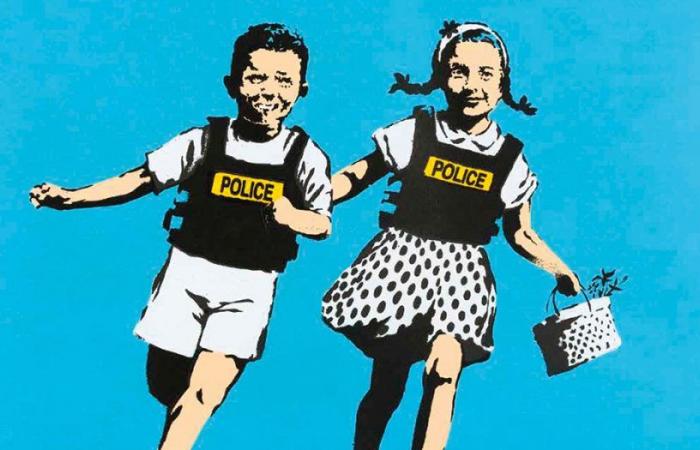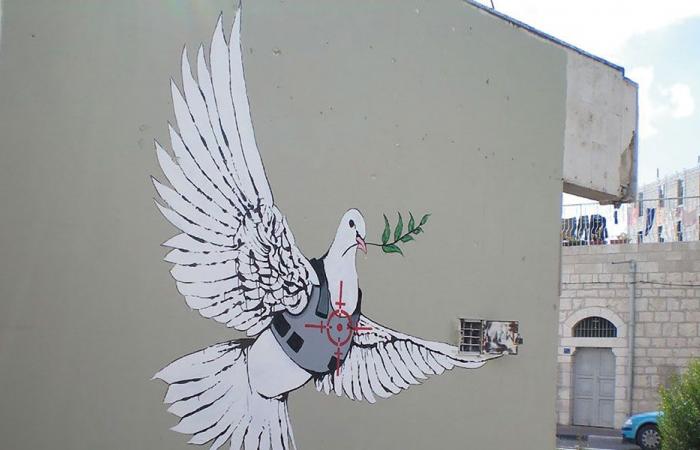A teenage girl in profile and a heart-shaped balloon flying. This is perhaps the most famous work of Banksyan image that today enjoys a fame equal to that of Mona Lisa Leonard. The work fuses two themes that are light for humanity: love and youth, condensed in the invisible line that joins the girl’s eyes as the balloon flies. Banksy succeeded where many failed, crossing the threshold of museums with the most feared universal symbol, that shape of the red heart that here becomes a sign of hope for a world where caring is synonymous with sharing and rebirth.
If we stop at the career of the most famous and mysterious of urban artists, we discover that ‘Girl with Balloon’ is just one more example of a constant dialogue with childhood and adolescence. The Bristol artist, author of murals that have become sought-after screen prints, feels the urgency of protecting young people from bad government, unjust laws or the little interest that the powerful reserve for them. Robin Gunningham (real name of the artist) was born and raised in Bristol, a working-class and multiracial city where he built, wall after wall, his ethical messages with his face covered. Behind the mask he has created dozens of stencils (templates on which he then screenprints with paint) that look like warnings for a young man who burns without being consumed, almost as if he had a fire of generational freedom of expression, a hymn to the generous and wild vitality of the dreamers.
‘Girl with Balloon’ is Banksy’s most popular image. It was voted in 2017, in a survey promoted by Samsung, as the most loved work by the British.. Banksy painted it for the first time with the stencil technique, in a schematic way, on a wall next to a bridge in the Southbank area of London, in 2004. The artist, who captured the work on an electric shed, He signed it at the bottom right with a text that says: “There is always hope.”
In his book ‘Cut it Out’ where the artist published the work in 2004, he adds: “When it is time to leave, leave quietly, without making noise.” The artist placed another version in the London neighborhood of Shoreditch, near Liverpool Street station. The owners of the store on whose wall the work appears thought about reselling it at auction, provoking such popular outrage that the work finally stayed where it was. Ten years later, hiding behind an advertising billboard, unknown people took her away.
The work reappeared during the presentation of the ‘Stealing Banksy?’ project. in 2014 and was then sold shortly after. Our dear girl, a universal symbol of hope for sensitive hearts, belongs to a large group of girls and boys who populate Banksy’s walls. Take as an example ‘Jack & Jill’, two teenagers running around in police bulletproof vests. They represent the best way to dismantle the rhetoric of control, playing with the stereotypes of social fears, using irony as a weapon that disrupts the meaning of things.
The British artist wrote about this work: “Many parents would be willing to do anything for their children except let them be themselves.” Phrase that denotes a special love for this indomitable age of young people who do not settle and fight while they play and love. ‘Bomb Love’, the work in which a girl hugs a bomb as if it were a stuffed animal, perfectly explains the narrative mechanism with which Banksy deactivates the insane reasons of power.
A gentle gesture to extinguish the deadly burning of the bomb, the proof of that love and youth are the best formula to be reborn in a society that will only grow by protecting new generations and the moral values of a civil community.
Bulletproof vests
‘Jack & Jill’ aims to act on perception, on the paradox that puts into tension the presumed innocence of childhood, the concerns of parents and the negative tendency that feeds an increasingly militaristic and warlike society. Banksy often uses bulletproof vest as in one of his versions of the peace dove painted in Palestine in 2007, titled ‘Armored Dove of Peace’, the bird wears a bulletproof vest.
‘Bomb Love’ has this official title and one adopted by the public, ‘Bomb Hugger’, the one that embraces the bomb. The image was published in 750 screen prints during demonstrations in Great Britain to criticize the joint intervention with the United States against Iraq. The artist talks about the war with the version that the rulers and the media give to justify the attack on Iraq, that is, a war to “export democracy.” In the 2001 book ‘Banging your head against a brick wall’, Banksy links the image to one of his aphorisms: “A wall is a very powerful weapon, it is the hardest thing you can hit someone with.” The image was reproduced in various formats and appeared on the walls of European cities such as Berlin and on posters distributed to the public during anti-militarist protests.
Banksy is a true artist on the side of people and the ethical values that matter, aware that The wall is a means of communication, a kind of urban setting in which to leave universal messages, both in its form and in its content. On the walls his art illuminates for everyone, full of positive values and a sense of reality, full of young protagonists who send messages to adults and all those who should make the world a better place. I would end with a quote from Banksy that sums up the historical moment well: “The biggest crimes in the world are not committed by people who break the rules, but by people who follow the rules. “It is the people who follow orders who throw the bombs and massacre the people.”
*Original report published in the May 2024 issue of Donne Chiesa Mondo. Translation of New Life







